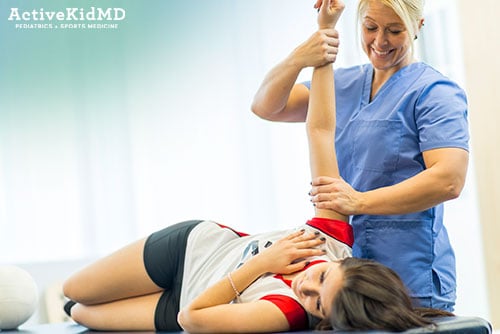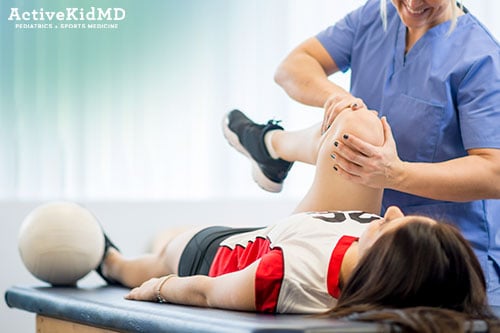
10 May Six Common Volleyball Injuries- and How to Prevent Them!
Working with Olympic level male and female volleyball players has allowed me a unique appreciation for common volleyball injuries. Since there are six players on the court, I will identify six common volleyball injuries with a focus on key prevention tips for players of all ages.
1) Concussions
Most of the concussions I encounter are seen in liberos or defensive specialists. They usually occur from direct ball to head impact or collisions with other players or objects (poles, chairs on courtside) when diving for a ball. I have also seen a fair amount of concussions resulting from mismatches on the court, namely defensive players trying to return serves or hits from much stronger and older players.
Any new sign of concern (such as dizziness, headache, blurred vision) or behavior change after head trauma should mandate removing the player from all activity. A player should not return until evaluated and cleared by a sports medicine specialist who is familiar with concussion care.
RELATED CONTENT: Information on sports-related concussions
Prevention tips for the volleyball player include:
- calling for balls before starting a dive or passing
- ensuring defensive players are aware of incoming balls during hitting/serving drills
- reducing the number of free balls in air at one time during hitting/serving drills
- limiting older and stronger players from hitting into younger players
- protecting the boundaries of the court to limit impact with chairs or other objects.
2) Shoulder injuries
Between serving, setting, passing, hitting, blocking and diving, it should be no surprise that shoulder problems are among the most common volleyball injuries.

Photo courtesy of USA Volleyball
Most shoulder injuries are due to repetitive use and overload stress leading to common abnormalities.

- Tightness in the front of the chest leading to a more forward position of the dominant shoulder
- Reduced function of the rotator cuff muscles, leading to pain and decreased hitting and serving accuracy and speed.
- Tightness in the back of the shoulder can decrease the follow-through phase of hitting or serving leading to problems with the labrum (soft tissue past between the ball and socket), inside of the elbow, and even lower back.
Appropriate stretching exercises combined with strengthening exercises of the scapula (wingbone) can reduce the risk of shoulder overuse injuries. Avoid hitting and serving with signs of fatigue (balls tend to go long with reduced speed) or any form of shoulder pain. Reducing the overall number of hits/serves can help, but more formal hit or serve count recommendations have not been studied at this time.
3) Finger/Hand Injuries
Tend to see finger joint sprains and dislocations mostly with blocking at the net. Rigid wrists with widespread and relaxed fingers not only allow better downward ball placement in the opponents court, but also reduce chances for volleyball injuries.
The widespread finger position places unique stress on the skin between the fingers leading to breaks in the skin that are extremely difficult to heal, even with sutures. Better to prevent these lacerations in the first place by moisturizing the skin between the fingers on a daily basis.
4) Low Back Pain
Volleyball-related back pain can come either from leaning forward (passing or following through on a serve/hit) or leaning back (setting or initiating a serve/hit).
- Pain that is more with leaning forward could cause issues with the discs between the bones of the lower spine.
- Pain leaning back could lead to stress injuries of the bones or joints.
Learning how to initiate movements with the gluteal muscles in the buttock area can reduce stress on the lower back, especially with jumping. Single leg gluteal strengthening activities are particularly recommended. Certain technical errors, such as reaching too far for passing or hitting, can also increased forces on the lower back. Setters should attempt to make contact with balls right above their head- avoid reaching too far forward for front sets or backwards on back sets.
5) Knee Pain
If you are a volleyball player who doesn’t have knee pain, then either you are extremely fortunate or perhaps in a bit of denial.

Photo courtesy of USA Volleyball
The repetitive jumping in volleyball often leads to pain in the front of the knee. Throw in frequent knee contact with the hard wood court surface and you have a recipe for knee problems.
For healthier volleyball knees, pay attention to the following recommendations:

- Avoid landing on straight knees. Always land and move “softly” with hips, knees and ankles in a bent position.
- Try to land in good alignment, with the hips and kneecaps lined up with the second toe. Don’t let your knees collapse in or rotate.
- Initiate jumps with the gluteal muscles in the buttock region. This will improve knee and also lower back function.
- The best time to stretch the muscles that support knee function is after practice or after a match when the muscles are warm. Focus on hamstrings, quadriceps, hip adductors/abductors and calf muscles.
- Knee pads help reduce bruises and pounding, especially with repetitive diving drills.
6) Ankle Sprains
Ankle sprains are the most common acute volleyball injury. Very few things spark intense debate more than the question about using ankle braces to prevent these type of injuries.
- The majority of ankle sprains are when the ankle inverts (rolls in)
- This most often occurs with play at the net where athletes make contact with another players foot when landing from a jump
- More chaotic play such as with bad passes or plays out of system can also put ankles at risk.
The theory behind bracing is to reduce abnormal ankle motion. Some fear that depending on bracing might make lower leg supporting muscles weaker and maybe even increase the risk of knee injuries.
RELATED CONTENT: Should indoor volleyball players wear ankle braces?
After an ankle sprain, little doubt that combining braces and appropriate rehabilitation exercises can reduce future injury risk.
